| Back to Back Issues Page |
 |
|
Bangkok Travelbug November13 Petrified Wood Museum - Korat October 29, 2013 |
| Hello
The process of petrification Petrification is a process in which wood is gradually turned to stone! The word is derived from the Greek word, “petros” meaning stone. The leader of the 12 apostles in the New Testament was called Simon He was later renamed Simon Peter or Petros, rock in Greek, “upon this rock I will build my church.” Petrification takes place when minerals permeate or seep through the pores of wood over a long period, estimated to be millions of years. The organic cells in the wood are gradually replaced by minerals and the wood is converted to stone or “petrified.” 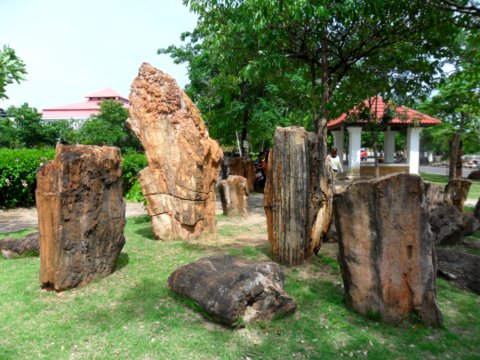
Display in the garden of the Petrified Wood Museum When there’s a volcanic eruption, larva overflows and buries entire forests. The wood remains buried for millenniums and petrification takes place. The same process occurs when forests are flooded and buried under heavy sediment. 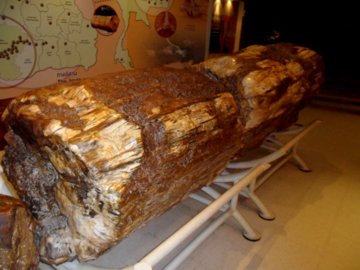
Petrified tree trunk What’s the difference between fossilization and petrification? Fossilization is the process in which evidence of life, organisms, marks or footprints, is preserved in rock. One of these processes is mineral replacement or petrification. So petrification is one form of fossilization. Petrified wood has been found in Argentina, China, Egypt, Greece, New Zealand and USA. Exhibits of petrified wood are usually displayed in museums of natural history along with other exhibits. The branch of study of petrified wood is called Palaeobotany (old botany, study of plant remains from old environments). The Petrified Wood Museum in Korat is one such museum. Table of contents History of the Petrified Wood Museum The first petrified wood relic found in 1921 in the Mun River*, in Chaleom Phrakiat district, Korat during the construction of the railway line through north-east Thailand. This rare find was presented by the Chief Engineer to King Rama VI during a royal visit. Since then numerous discoveries of petrified wood were made in Korat during the construction of the Mitraphap Highway through Issarn (NE Thailand). The oldest pieces of petrified wood were found in Pak Chong and Wang Nam Khiew districts. These were assessed to be conifers from the Dinosaur Age in the late Jurassic period about 150 million years ago. Though petrified wood relic are present is most provinces in the north-east, the greatest concentration of these relics is in Nakhon Ratchasima (Korat). The two largest sites are in Khok Kruat and Suranaree sub-districts, the latter being the location of the Petrified Wood Museum. 
To prevent further loss of these precious relics, a conservation plan was drawn up and plans were made for a museum to preserve the petrified wood found in the area. Note The Mun River drains from west to east across the Korat plateau in NE Thailand and finally joins the Mekong River at the Thai-Laos border. Table of contents Tour of the Petrified Wood Museum The Petrified Wood Museum is divided into four sections:
Let’s take a walk through and view these rare and unusual exhibits. Garden After you have bought your tickets from the reception building, you’ll walk through a path through the beautiful garden to get to the main museum buildings. There’s a huge lake in the garden. 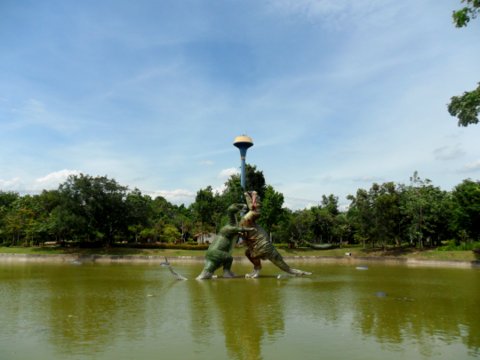
There are several displays of petrified wood in the garden that provide wonderful photo opportunities. At a cursory glance, you could easily have mistaken some of them for stone. 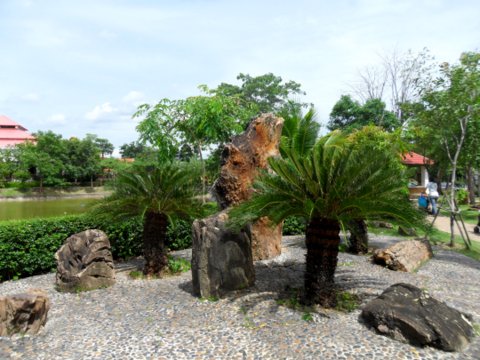
Displays of petrified wood in the garden Here’s a close-up of some of these pieces of petrified wood. Some of them do look like rock. 
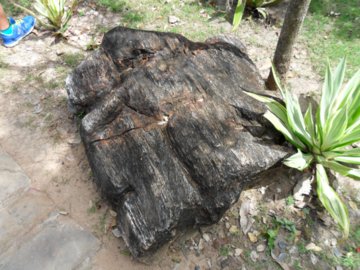
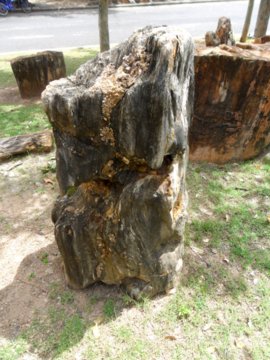


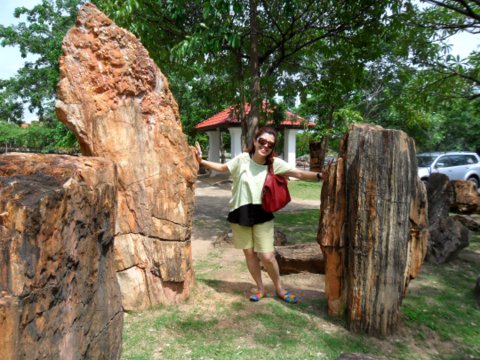
Rose among dead wood Sirindhorn Building 
Sirindhorn Building, Petrified Wood Museum This is the main building where the petrified wood discovered in the area is displayed. 
Petrified tree trunk Some of the petrified wood has got an almost gem-like quality. 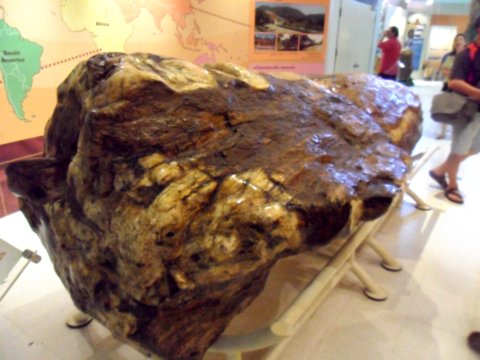


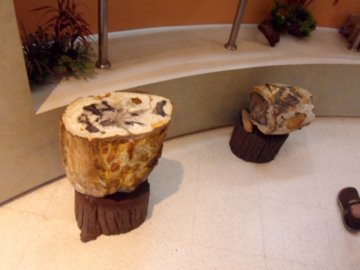
Fossil Proboscidean Museum The second building displays fossils of Proboscideans, an order of mammals including the elephant and their extinct relatives. Their characteristics are a long trunk, tusks and thick column-like legs. 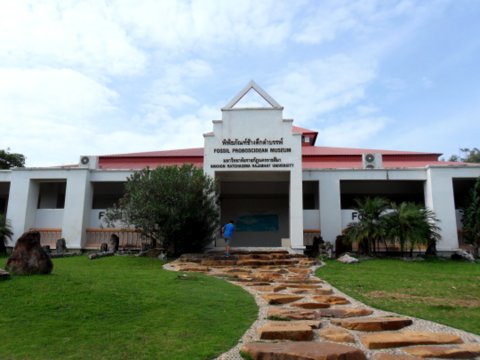
Fossil Proboscidean Museum This museum was established by the Nakhon Ratchasima Rajabhat University and the exhibits consist of the fossils of complete skeleton of an elephant and tusks. 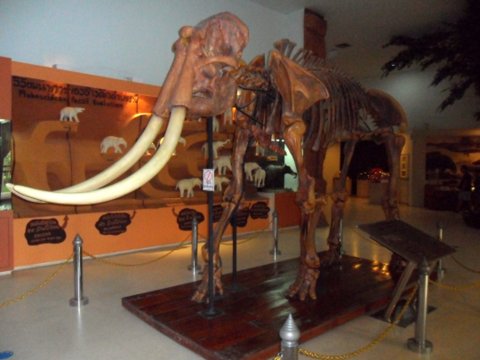
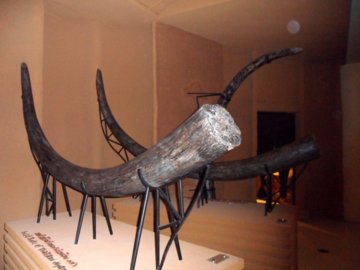


Dinosaur fossils The third building displays of dinosaur fossils. 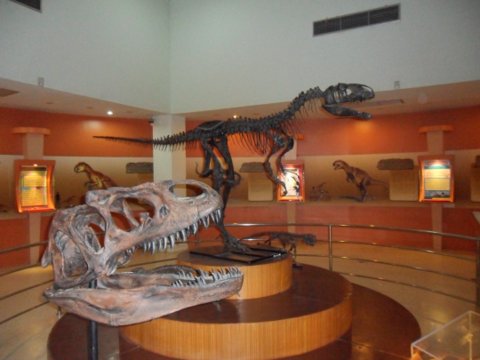
A more comprehensive display of such fossils can be found in the Sirindhorn Museum, Kalasin. 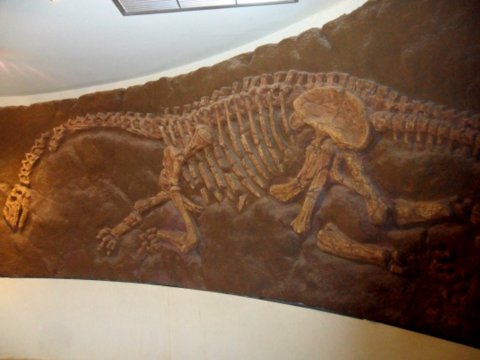
With that we end our tour of the Petrified Wood Museum with its interesting displays and beautiful garden. 
Parting shot of the Petrified Wood Museum Admission Foreign adults – 100 baht, children – 50 baht If you are a foreigner working in Thailand, you can get a concession at the Thai price if you show your work permit. This concession however does not extend to your family. Thai adults – 30 baht, university students - 20 baht, school students 10 baht Free – monks, senior citizens (above 60 years), disabled persons Opening hours Tuesdays – Sundays 0900 – 1600 hours Closed on Mondays Table of contents Map to the Petrified Wood Museum View Petrified Wood Museum, Korat in a larger map How to get to there By car Take Highway 2 or the Mittraphap Highway to Korat city which is about 260 km from Bangkok. It’s about a three hour drive to Korat city. When you get to the city and turn right into Highway 304, the way to Pak Thong Chai. Drive on for about 12 km and turn right at the road leading to the Suranari Technological University. You will come to a forked junction, take the left fork and drive on for another 2.5 km till you see the museum on your right. By tour bus If you are using public transport, there are express tour buses from the Northern Bus Terminal at Mor Chit in Bangkok to the Korat bus terminal 2 (new terminal). This takes about three and a half hours and doesn’t cost more than 200 baht. If possible don’t take the air-conditioned non-express bus (class 2). It takes almost four and half hours (fare 171 baht). By mini-bus The mini- buses from the Victory Monument take three hours but terminate at Pak Chong (fare 180 baht). You will have to take another mini-bus to Korat city (fare 60 baht). Mini-buses from Mor Chit go directly to the bus terminal 2 in Korat city. Getting around Korat The most convenient form of public transport is the tuk tuk. These are available at the bus terminal and also at major junctions. If you are going to an out-of-the-way place like the Petrified Wood Museum, you’ll need to charter the tuk tuk for a return trip. Agree on the price before boarding. Table of contents Other pre-historic museums I have visited in north-east Thailand Khon Kaen National Museum The Dinosaurs of Kalasin There’s another dinosaur in Khon Kaen, the Phu Wiang Dinosaur Museum in Khon Kaen which I haven’t visited. Table of contents My thanks My thanks to my travelling companions Lim Siew Hwei who drove us, Wong Keng Cheong, Sally and family and cousin Mark. Thank you for the company and the wonderful meals we had together. Table of contents Next month Wang Matcha Restaurant – an unique dining experience 

If you enjoyed reading this e-zine, please forward it to a friend. If you received this from a friend and found it interesting, please subscribe at Bangkok Travelbug. What you think of the Bangkok Travelbug? We love to hear from you What other subscribers have said Till next month then. Eric Lim Find us on Facebook Stay updated with what’s new at Tour Bangkok Legacies. Copy the link below and paste it into your Google Reader, NetNewsWire or your favourite feed reader. https://www.tour-bangkok-legacies.com/tour-Bangkok-legacies.xml If you use My Yahoo! or My MSN, head over to my home page and click on the button for your favourite Web-based feed reader. Visit our home page at Tour Bangkok Legacies. Copyright@2008-2013 Tour Bangkok Legacies All rights reserved
|
| Back to Back Issues Page |